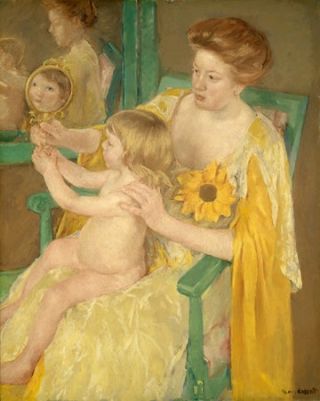
The United States is unique in its preoccupation with the proper way to raise children.
Americans write and read more childrearing books than those in any other nation—and worry more incessantly about children’s well-being.
As a result, it is impossible for American parents to rear children intuitively or un-self-consciously.
Today’s parents face a barrage of difficult decisions and contradictory advice: to bottle-feed or breast feed; to co-sleep or use a crib; to use a stroller or a sling, and on and on.
But disagreements among childrearing experts are nothing new. Indeed, every era has been buffeted with clashing and conflicting counsel, often pitting those who emphasize parental authority and discipline against those who advocate affection and bonding. Since the late nineteenth century, every generation has had experts advocating a style of parenting that they claim is buttressed by science—only to be challenged by other authorities claiming scientific validation for their approach.
The 1920s illustrates the conflicts among experts particularly vividly. There was a sharp dispute between three distinct groups of experts. Behaviorists, like the psychologist John B. Watson, advised mothers to avoid hugging, kissing, or playing with their infants and to rigidly schedule feeding and sleeping, lest their children fail to develop a capacity for self-discipline and self-control. Child development specialists, led by Arnold Gesell, tied certain traits to children’s age and stage of development. At the same time early Freudians anticipated Dr. Benjamin Spock by calling for a more loving relationship between mother and infants, but also worried intensely about the dangers of maternal over-involvement.
What linked these contrasting points of view was a fear that any dysfunction in mother-child relationship would lead to lifelong psychological maladjustments.
Let’s recap the history of “modern” childrearing advice in a nutshell.
The late nineteenth century marked the birth of a scientific approach to childrearing advice. Supplanting earlier childrearing tracts, which were written by ministers and moralists, were works by physicians and psychologists.
Deeply concerned about high rates of infant and child mortality, authors such as Dr. L. Emmett Holt believed that mothers required expert advice about hygiene, health, and raising children properly. Holt, the Dr. Spock of his age, called upon mothers to adopt a regimented approach to childrearing, and to impose strict sleeping and feeding schedules.
Why did parents increasingly seek “scientific” advice? The explanation is straightforward: Various societal changes greatly intensified parents’ anxiety about their children’s economic future, values, and physical and psychological well-being.
Three developments stand out. First, as the American economy developed, parents found it harder to transmit their class position directly to their children. Children’s future success hinged, parents came to believe, on instilling the proper values and character traits in their offspring. During the first half of the twentieth century, parents viewed toys as a way to cultivate “proper” gender roles, with dolls intended to cultivate nurturing qualities in girls and construction toys essential for instructing boys in design, planning, and building. Household chores, in exchange for an allowance, were a mechanism for ensuring that that children developed an ability to delay gratification and an awareness of the value of money. Boys’ sports came to be viewed as an ideal vehicle for instilling self-discipline, to foster and channel aggressiveness, and to cultivate a capacity for team-work.
Second, as young people’s schooling increased and leisure time expanded and as a consumer society grew and commercial amusements proliferated, parents faced new challenges in monitoring their children’s school performance, supervising and regulating their behavior outside the home, and overseeing their relations with peers.
Third, the “triumph of the therapeutic”—the growth of medical and psychological expertise—led parents to worry about aspects of life that elicited little concern in the past, such as children’s posture, sleep habits, siblings bonds, and psychological well-being. In our own time, anxiety has swirled around children’s allergies, attention deficit disorder, autism, Sudden Infant Death Syndrome—perils to which earlier generations were blind.
During the 1920s, the tenets of scientific childrearing, still upheld by authorities like John B. Watson, came under attack by advocates of new familial ideal: the “companionate” family. According to this ideal, "moms" and "dads" (new words during the decade) were to be their children's big pals. The new economy of the 1920s was thought to demand new kind of personality—less reserved and restrained and more outgoing—which was best nurtured in a more loving family environment.
The 1930s saw the psychologizing of motherhood. Freudian psychoanalysis sent the message that infancy and early childhood were critical for child development and that even the smallest mistake in mothering carried devastating consequences.
When tens of thousands of potential soldiers were deemed unfit for military service in World War II, expert opinion launched an attack on "Momism"—the supposedly damaging effects of smother love and over-solicitous mothering—and upon its polar opposite, maternal neglect.
Following the war, Dr. Benjamin Spock popularized a Freudian approach to childrearing. Spock rejected strict scheduling and advised mothers to trust themselves. But despite his association with “permissiveness” in childrearing, Spock insisted on the importance of mothers and fathers setting and enforcing clear boundaries on children’s behavior.
The 1970s saw the emergence of paranoid parenting, as parental anxiety mounted and mothers became increasingly aware of a host of threats to their children's physical and emotional well-being. The “discovery of risk” carried profound consequences for children’s upbringing. Parents kept their kids under closer supervision, kept them indoors much more than in the past, and narrowed the geography in which children were allowed to roam. In part, the emphasis on risk represented a response to a host of unsettling developments, including rising rates of divorce, single parenthood, and working mothers.
The 1970s, 1980s and 1990s also witnessed the politicization of childrearing advice with bitter disputes about breastfeeding, pacifiers, spanking, co-sleeping, and vaccination. Partisan and religious divides emerged in attitudes toward forms of discipline and structure within families, with social conservatives tending to favor greater emphasis on parental authority and liberals preferring time-outs and reasoning with children to any form of physical punishment.
It’s not surprising that at a time when the composition of families frequently shifted as parents partnered and re-partnered, attachment parenting became popular. It not only promised to give children a strong sense of stability and connection, it was also said to contribute to a child’s self-esteem that would provide the resilience that children need in an insecure, ever-changeable environment.
Meanwhile, the growing popularity of attachment parenting reflected a fundamental shift in parent-child relations. No longer did parents expect their child’s love; they felt they had to earn that love.
As economic growth slowed and family incomes stagnated, childrearing advice increasingly focused on ways to foster children who would be successful in a highly competitive society. The early twenty-first century marked the rise of intensive parenting—including the highly involved soccer mom, the hovering helicopter parent, and hyper-ambitious Tiger Mom—prompting a reaction among those who called for more relaxed form of “free-range” parenting, which claimed to produce more creative and imaginative children.
If any lesson can be drawn from this contentious history, it is that childrearing advice is never simply about the best ways to promote children’s health, happiness, or psychological well-being. It invariably reflects their parents' fears and their sense of the kind of future that their children need to be prepared for.




